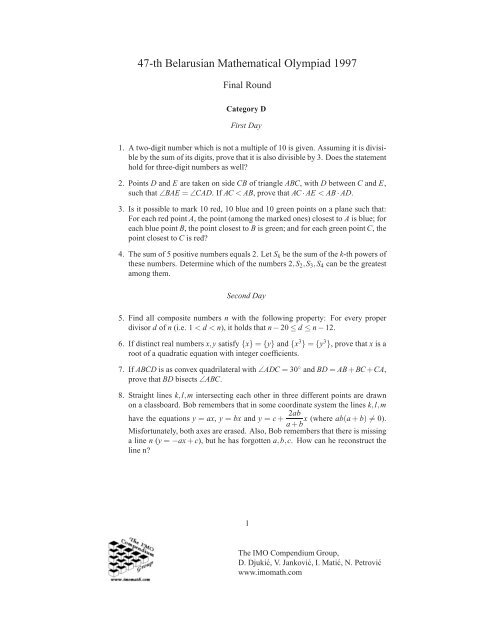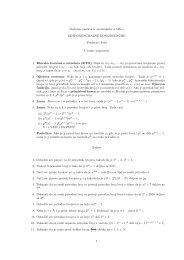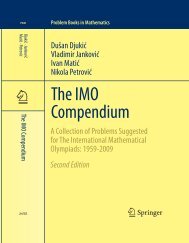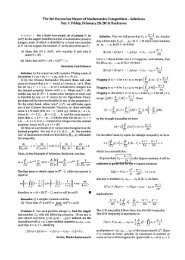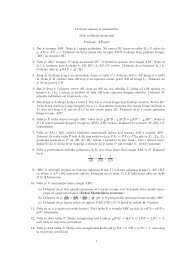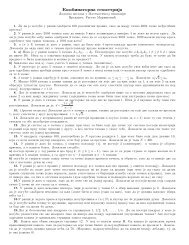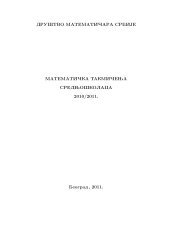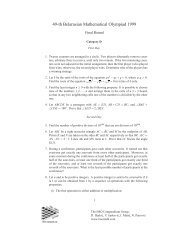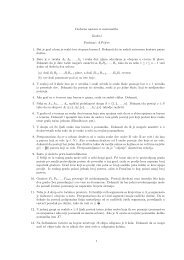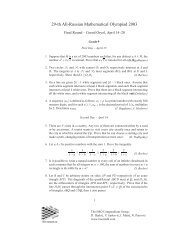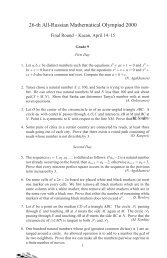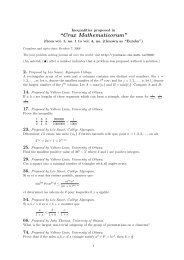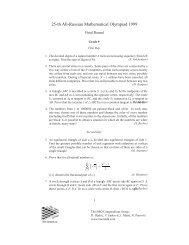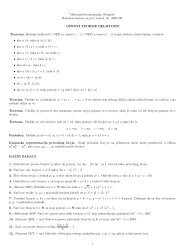47-th Belarusian Mathematical Olympiad 1997 - IMOmath
47-th Belarusian Mathematical Olympiad 1997 - IMOmath
47-th Belarusian Mathematical Olympiad 1997 - IMOmath
Create successful ePaper yourself
Turn your PDF publications into a flip-book with our unique Google optimized e-Paper software.
<strong>47</strong>-<strong>th</strong> <strong>Belarusian</strong> Ma<strong>th</strong>ematical <strong>Olympiad</strong> <strong>1997</strong><br />
Final Round<br />
Category D<br />
First Day<br />
1. A two-digit number which is not a multiple of 10 is given. Assuming it is divisible<br />
by <strong>th</strong>e sum of its digits, prove <strong>th</strong>at it is also divisible by 3. Does <strong>th</strong>e statement<br />
hold for <strong>th</strong>ree-digit numbers as well?<br />
2. Points D and E are taken on side CB of triangle ABC, wi<strong>th</strong> D between C and E,<br />
such <strong>th</strong>at ∠BAE = ∠CAD. If AC < AB, prove <strong>th</strong>at AC · AE < AB · AD.<br />
3. Is it possible to mark 10 red, 10 blue and 10 green points on a plane such <strong>th</strong>at:<br />
For each red point A, <strong>th</strong>e point (among <strong>th</strong>e marked ones) closest to A is blue; for<br />
each blue point B, <strong>th</strong>e point closest to B is green; and for each green point C, <strong>th</strong>e<br />
point closest to C is red?<br />
4. The sum of 5 positive numbers equals 2. Let S k be <strong>th</strong>e sum of <strong>th</strong>e k-<strong>th</strong> powers of<br />
<strong>th</strong>ese numbers. Determine which of <strong>th</strong>e numbers 2,S 2 ,S 3 ,S 4 can be <strong>th</strong>e greatest<br />
among <strong>th</strong>em.<br />
Second Day<br />
5. Find all composite numbers n wi<strong>th</strong> <strong>th</strong>e following property: For every proper<br />
divisor d of n (i.e. 1 < d < n), it holds <strong>th</strong>at n − 20 ≤ d ≤ n − 12.<br />
6. If distinct real numbers x,y satisfy {x} = {y} and {x 3 } = {y 3 }, prove <strong>th</strong>at x is a<br />
root of a quadratic equation wi<strong>th</strong> integer coefficients.<br />
7. If ABCD is as convex quadrilateral wi<strong>th</strong> ∠ADC = 30 ◦ and BD = AB+BC+CA,<br />
prove <strong>th</strong>at BD bisects ∠ABC.<br />
8. Straight lines k,l,m intersecting each o<strong>th</strong>er in <strong>th</strong>ree different points are drawn<br />
on a classboard. Bob remembers <strong>th</strong>at in some coordinate system <strong>th</strong>e lines k,l,m<br />
have <strong>th</strong>e equations y = ax, y = bx and y = c + 2ab x (where ab(a+b) ≠ 0).<br />
a+b<br />
Misfortunately, bo<strong>th</strong> axes are erased. Also, Bob remembers <strong>th</strong>at <strong>th</strong>ere is missing<br />
a line n (y = −ax+c), but he has forgotten a,b,c. How can he reconstruct <strong>th</strong>e<br />
line n?<br />
1<br />
The IMO Compendium Group,<br />
D. Djukić, V. Janković, I. Matić, N. Petrović<br />
www.imoma<strong>th</strong>.com
Category C<br />
First Day<br />
1. A positive integer N is a sum of two nonzero squares m 2 and n 2 . Prove <strong>th</strong>at none<br />
of divisors of N can be written in <strong>th</strong>e form m k − n k for k ≥ 2.<br />
2. If two-digit numbers a and b have <strong>th</strong>e same digits in reverse order, find <strong>th</strong>e least<br />
possible value of | a b − 2|.<br />
3. Points D,M,N are chosen on <strong>th</strong>e sides AC,AB,BC of a triangle ABC respectively,<br />
so <strong>th</strong>at <strong>th</strong>e intersection point P of AN and CM lies on BD. Prove <strong>th</strong>at BD is a<br />
median of <strong>th</strong>e triangle if and only if AP : PN = CP : PM.<br />
4. An equilateral triangle ABC of side n is divided into n 2 equilateral triangles of<br />
side 1. All vertices of small triangles is labeled wi<strong>th</strong> numbers - A,B,C, and a<br />
point D on <strong>th</strong>e distance √ 3 from C are labelled by 1, and all o<strong>th</strong>er points by<br />
0. In each move it is allowed to increase or decrease by 1 all <strong>th</strong>e four vertices<br />
of a rhombus of side 1. Find all numbers n ≥ 3 for which we can make all <strong>th</strong>e<br />
numbers vanish.<br />
Second Day<br />
5. Prove <strong>th</strong>at <strong>th</strong>ere exist infinitely many triples (a,b,c) of integers satisfying<br />
a 3 − 3ab − b 3 = b 3 + 3bc+c 3 = 1.<br />
6. A finite number of lines are drawn in a plane. Determine whe<strong>th</strong>er <strong>th</strong>e following<br />
statement is true: There always exists a line a among <strong>th</strong>e drawn lines such <strong>th</strong>at<br />
all intersection points of <strong>th</strong>e lines are in <strong>th</strong>e same halfplane determined by a, or<br />
on a.<br />
7. We are given a mechanism <strong>th</strong>at can perform <strong>th</strong>e following operations:<br />
• Joining any two points of a plane by a straight line;<br />
• Constructing <strong>th</strong>e reflection X of a given point P in a given line l.<br />
Given a triangle ABC, using <strong>th</strong>e given mechanism, construct (a) its centroid; (b)<br />
its circumcenter.<br />
8. An archipelago consists of n islands. Some of <strong>th</strong>e islands are pairwise connected<br />
by bridges (maybe zero or more <strong>th</strong>an one). It is known <strong>th</strong>at from any island one<br />
can arrive to any o<strong>th</strong>er island, and <strong>th</strong>at <strong>th</strong>e first island has 1 bridge, <strong>th</strong>e second 4,<br />
..., <strong>th</strong>e n-<strong>th</strong> n 2 bridges. Find all n for which such an archipelago can exist.<br />
2<br />
The IMO Compendium Group,<br />
D. Djukić, V. Janković, I. Matić, N. Petrović<br />
www.imoma<strong>th</strong>.com
Category B<br />
First Day<br />
1. A pentagon A 1 A 2 A 3 A 4 A 5 is inscribed in a circle, B being <strong>th</strong>e intrersection point<br />
of A 1 A 4 and A 2 A 5 . Given <strong>th</strong>at ∠A 4 A 1 A 3 = ∠A 5 A 2 A 4 and ∠A 2 A 4 A 1 = ∠A 3 A 5 A 2 ,<br />
prove <strong>th</strong>at ∠A 1 A 3 B = ∠BA 3 A 5 .<br />
2. Let M be <strong>th</strong>e set {0,1,2,4,5,6,...,n} and let s : M → M be a bijection. Find,<br />
for various n, all possible values of <strong>th</strong>e greatest common divisor of <strong>th</strong>e numbers<br />
i+s(i), i ∈ M.<br />
3. In a solving riddles contest, 5 riddles were proposed. After <strong>th</strong>e contest, every<br />
jury member assigned to each riddle some positive integer number of points, and<br />
determined a winner. Curiously, every contestant was determined as a winner by<br />
at least one jury member. Find <strong>th</strong>e greatest possible number of participants (a<br />
riddle is ei<strong>th</strong>er solved (full points) or unsolved (0)).<br />
4. On each cell of a 8 × 8 chessboard b<strong>th</strong>ere is a white or black pawn. It is known<br />
<strong>th</strong>at any black pawn has an odd number of white neighbours, while any white<br />
pawn has an even number of black neighbours (two pawns are neighboring whenever<br />
<strong>th</strong>eir cells share a vertex).<br />
(a) Find <strong>th</strong>e greatest possible number of black pawns.<br />
(b) Prove <strong>th</strong>at <strong>th</strong>e central 4×4 square contains an even number of black pawns.<br />
Second Day<br />
5. In a trapezoid ABCD wi<strong>th</strong> AB ‖ CD it holds <strong>th</strong>at ∠ADB+∠DBC = 180 ◦ . Prove<br />
<strong>th</strong>at AB · BC = AD · DC.<br />
6. There are n red and n blue points on a straight line l. Prove <strong>th</strong>at <strong>th</strong>ere is a point<br />
M on l such <strong>th</strong>at <strong>th</strong>e sum of distances from M to <strong>th</strong>e blue points is equal to <strong>th</strong>e<br />
sum of distances from M to <strong>th</strong>e red points. Is <strong>th</strong>is statement true if <strong>th</strong>e n blue and<br />
n red points are arbitrarily given in a plane?<br />
7. The polynomials x,x 3 ,x 5 ,... are written on a classboard. New polynomials are<br />
written according to <strong>th</strong>e following rule: if f(x) and g(x) have been already written,<br />
one can write any of <strong>th</strong>e polynomials f(x)+g(x), f(g(x)) and a f(x)+b for<br />
any a,b ∈ R. Is it possible to obtain a polynomial of <strong>th</strong>e form x 2k+1 − 19x+97,<br />
where k is a positive integer?<br />
8. The sum of n real numbers is positive. Find <strong>th</strong>e smallest possible number of <strong>th</strong>eir<br />
pairwise sums <strong>th</strong>at must be positive.<br />
3<br />
The IMO Compendium Group,<br />
D. Djukić, V. Janković, I. Matić, N. Petrović<br />
www.imoma<strong>th</strong>.com
Category A<br />
First Day<br />
1. Different points A 1 ,A 2 ,A 3 ,A 4 ,A 5 lie on a circle so <strong>th</strong>at A 1 A 2 = A 2 A 3 = A 3 A 4 =<br />
A 4 A 5 . Let A 6 be <strong>th</strong>e diametrically opposite point to A 2 , and A 7 be <strong>th</strong>e intersection<br />
of A 1 A 5 and A 3 A 6 . Prove <strong>th</strong>at <strong>th</strong>e lines A 1 A 6 and A 4 A 7 are perpendicular.<br />
2. A sequence (a n ) ∞ n=−∞ of zeros and ones is given. It is known <strong>th</strong>at a n = 0 if<br />
and only if a n−6 + a n−5 + ···+a n−1 is a multiple of 3, and not all terms of <strong>th</strong>e<br />
sequence are zero. Determine <strong>th</strong>e maximum possible number of zeros among<br />
a 0 ,a 1 ,...,a 97 .<br />
3. If a,x,y,z are positive numbers, prove <strong>th</strong>e inequality<br />
x a+z<br />
a+x + ya+x a+y + za+y ≤ x+y+z ≤ xa+y<br />
a+z a+z + y a+z<br />
a+x + za+x a+y .<br />
4. A set M consists of n elements. Find <strong>th</strong>e greatest k for which <strong>th</strong>ere is a collection<br />
of k subsets of M wi<strong>th</strong> <strong>th</strong>e following property: For any subsets A 1 ,...,A j from<br />
<strong>th</strong>e collection <strong>th</strong>ere is an element belonging to an odd number of <strong>th</strong>em.<br />
Second Day<br />
5. We call <strong>th</strong>e sum of any k of n given numbers (wi<strong>th</strong> distinct indices) a k-sum.<br />
Given n, find all k such <strong>th</strong>at, whenever more <strong>th</strong>an half of k-sums of numbers<br />
a 1 ,...,a n are positive, <strong>th</strong>e sum a 1 + ···+ a n is also positive.<br />
6. Suppose <strong>th</strong>at a function f : R + → R + satisfies<br />
Prove <strong>th</strong>at f(x) ≥ x for all x.<br />
f(f(x))+x = f(2x).<br />
7. Does <strong>th</strong>ere exist an infinite set M of straight lines on <strong>th</strong>e coordinate plane such<br />
<strong>th</strong>at<br />
(i) no two lines are parallel, and<br />
(ii) for any integer point <strong>th</strong>ere is a line from M containing it?<br />
Does <strong>th</strong>e answer change if we add one more condition:<br />
(iii) any line from M passes <strong>th</strong>rough at least 2 integer points?<br />
8. A triangle A 1 B 1 C 1 is a parallel projection of a triangle ABC in space. The parallel<br />
projections A 1 H 1 and C 1 L 1 of <strong>th</strong>e altitude AH and <strong>th</strong>e bisector CL of △ABC<br />
respectively are drawn. Using a ruler and compass, construct a parallel projection<br />
of (a) <strong>th</strong>e or<strong>th</strong>ocenter; (b) <strong>th</strong>e incenter of △ABC.<br />
4<br />
The IMO Compendium Group,<br />
D. Djukić, V. Janković, I. Matić, N. Petrović<br />
www.imoma<strong>th</strong>.com


